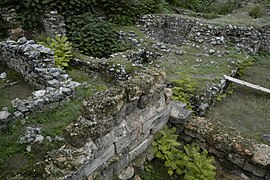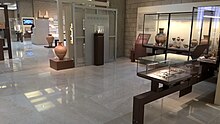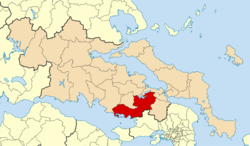Thebes, Greece
Thebes
Θήβα | |
|---|---|
 Remains of the Cadmea, the central fortress of ancient Thebes | |
 Thebes show Location within the region | |
| Coordinates: 38°19′N 23°19′E / 38.317°N 23.317°ECoordinates: 38°19′N 23°19′E / 38.317°N 23.317°E | |
| Country | Greece |
| Administrative region | Central Greece |
| Regional unit | Boeotia |
| Area | |
| • Municipality | 830.112 km2 (320.508 sq mi) |
| • Municipal unit | 321.015 km2 (123.945 sq mi) |
| Elevation | 215 m (705 ft) |
| Population (2011)[1] | |
| • Municipality | 36,477 |
| • Municipality density | 44/km2 (110/sq mi) |
| • Municipal unit | 25,845 |
| • Municipal unit density | 81/km2 (210/sq mi) |
| Demonym(s) | Theban |
| Community | |
| • Population | 22,883 (2011) |
| • Area (km2) | 143.889 |
| Time zone | UTC+2 (EET) |
| • Summer (DST) | UTC+3 (EEST) |
| Postal code | 32200 |
| Area code(s) | 22620 |
| Website | www |
Thebes (/ˈθiːbz/; Greek: Θήβα, Thíva [ˈθiva]; Ancient Greek: Θῆβαι, Thêbai [tʰɛ̂ːbai̯][2]) is a city in Boeotia, Central Greece. It played an important role in Greek myths, as the site of the stories of Cadmus, Oedipus, Dionysus, Heracles and others. Archaeological excavations in and around Thebes have revealed a Mycenaean settlement and clay tablets written in the Linear B script, indicating the importance of the site in the Bronze Age.
Thebes was the largest city of the ancient region of Boeotia and was the leader of the Boeotian confederacy. It was a major rival of ancient Athens, and sided with the Persians during the 480 BC invasion under Xerxes. Theban forces under the command of Epaminondas ended the power of Sparta at the Battle of Leuctra in 371 BC. The Sacred Band of Thebes (an elite military unit) famously fell at the Battle of Chaeronea in 338 BC against Philip II and Alexander the Great. Prior to its destruction by Alexander in 335 BC, Thebes was a major force in Greek history, and was the most dominant city-state at the time of the Macedonian conquest of Greece. During the Byzantine period, the city was famous for its silks.
The modern city contains an archaeological museum, the remains of the Cadmea (Bronze Age and forward citadel), and scattered ancient remains. Modern Thebes is the largest town of the regional unit of Boeotia.
Geography[]
Thebes is situated in a plain, between Lake Yliki (ancient Hylica) to the north, and the Cithaeron mountains, which divide Boeotia from Attica, to the south. Its elevation is 215 metres (705 feet) above mean sea level. It is about 50 kilometres (31 miles) northwest of Athens, and 100 kilometres (62 miles) southeast of Lamia. Motorway 1 and the Athens–Thessaloniki railway connect Thebes with Athens and northern Greece. The municipality of Thebes covers an area of 830.112 square kilometres (320.508 square miles), the municipal unit of Thebes 321.015 square kilometres (123.945 square miles) and the community 143.889 square kilometres (55.556 square miles).[3]
Municipality[]
In 2011, as a consequence of the Kallikratis reform, Thebes was merged with Plataies, Thisvi, and Vagia to form a larger municipality, which retained the name Thebes. The other three become units of the larger municipality.[4]
History[]
Mythic record[]


The record of the earliest days of Thebes was preserved among the Greeks in an abundant mass of legends that rival the myths of Troy in their wide ramification and the influence that they exerted on the literature of the classical age. Five main cycles of story may be distinguished:
- The foundation of the citadel Cadmea by Cadmus, and the growth of the Spartoi or "Sown Men" (probably an aetiological myth designed to explain the origin of the Theban nobility which bore that name in historical times).
- The immolation of Semele and the advent of Dionysus.
- The building of a "seven-gated" wall by Amphion, and the cognate stories of Zethus, Antiope and Dirce.
- The tale of Laius, whose misdeeds culminated in the tragedy of Oedipus and the wars of the Seven against Thebes and the Epigoni, and the downfall of his house; Laius' pederastic rape of Chrysippus was held by some ancients to have been the first instance of homosexuality among mortals, and may have provided an etiology for the practice of pedagogic pederasty for which Thebes was famous. See Theban pederasty and Pederasty in ancient Greece for detailed discussion and background.
- The exploits of Heracles.
The Greeks attributed the foundation of Thebes to Cadmus, a Phoenician king from Tyre (now in Lebanon) and the brother of Queen Europa. Cadmus was famous for teaching the Phoenician alphabet and building the Acropolis, which was named the Cadmeia in his honor and was an intellectual, spiritual, and cultural center.
Early history[]

Archaeological excavations in and around Thebes have revealed cist graves dated to Mycenaean times containing weapons, ivory, and tablets written in Linear B. Its attested name forms and relevant terms on tablets found locally or elsewhere include

